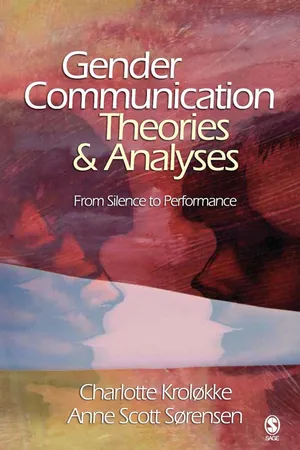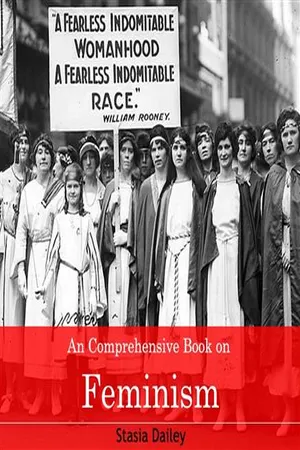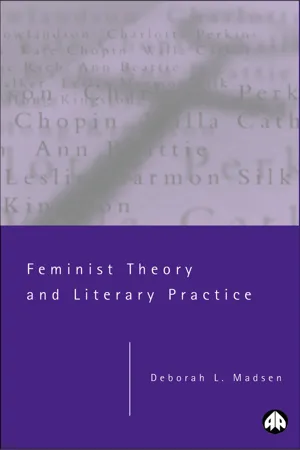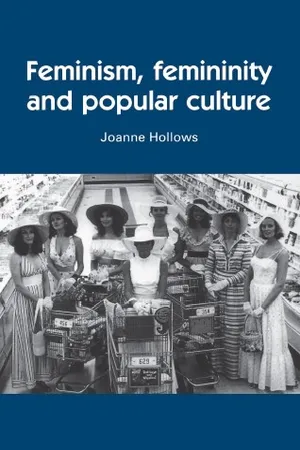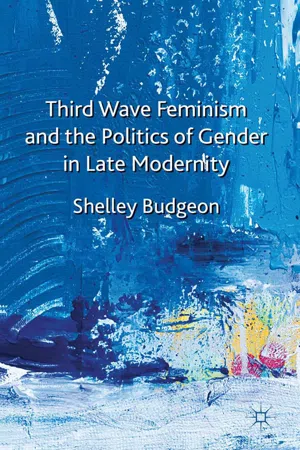History
First Wave Feminism
First Wave Feminism refers to the early feminist movement in the late 19th and early 20th centuries, primarily focused on women's suffrage and legal rights. It aimed to challenge traditional gender roles and achieve political and social equality for women. Notable achievements include the suffrage movement and the Seneca Falls Convention, which laid the groundwork for future feminist activism.
Written by Perlego with AI-assistance
Related key terms
1 of 5
11 Key excerpts on "First Wave Feminism"
- eBook - ePub
Gender Communication Theories and Analyses
From Silence to Performance
- Charlotte Krolokke, Anne Scott Sorensen(Authors)
- 2005(Publication Date)
- SAGE Publications, Inc(Publisher)
1 Three Waves of Feminism From Suffragettes to GrrlsW e now ask our readers to join us in an exploration of the history of feminism or, rather, feminisms: How have they evolved in time and space? How have they framed feminist communication scholarship in terms of what we see as a significant interplay between theory and politics? And how have they raised questions of gender, power, and communication?We shall focus our journey on the modern feminist waves from the 19th to the 21st century and underscore continuities as well as disruptions. Our starting point is what most feminist scholars consider the “first wave.” First-wave feminism arose in the context of industrial society and liberal politics but is connected to both the liberal women’s rights movement and early socialist feminism in the late 19th and early 20th century in the United States and Europe. Concerned with access and equal opportunities for women, the first wave continued to influence feminism in both Western and Eastern societies throughout the 20th century. We then move on to the second wave of feminism, which emerged in the 1960s to 1970s in postwar Western welfare societies, when other “oppressed” groups such as Blacks and homosexuals were being defined and the New Left was on the rise. Second-wave feminism is closely linked to the radical voices of women’s empowerment and differential rights and, during the 1980s to 1990s, also to a crucial differentiation of second-wave feminism itself, initiated by women of color and third-world women. We end our discussion with the third feminist wave, from the mid-1990s onward, springing from the emergence of a new postcolonial and postsocialist world order, in the context of information society and neoliberal, global politics. Third-wave feminism manifests itself in “grrl” rhetoric, which seeks to overcome the theoretical question of equity or difference and the political question of evolution or revolution, while it challenges the notion of “universal womanhood” and embraces ambiguity, diversity, and multiplicity in transversal theory and politics. - No longer available |Learn more
- (Author)
- 2014(Publication Date)
- Library Press(Publisher)
________________________ WORLD TECHNOLOGIES ________________________ Chapter- 1 History of Feminism Louise Weiss along with other Parisian suffragettes in 1935. The newspaper headline reads, in translation, THE FRENCHWOMAN MUST VOTE. The history of feminism involves the story of feminist movements. Most feminist historians assert that all movements that work to obtain women's rights should be considered feminist movements, even when they did not (or do not) apply the term to themselves. Other historians assert that the term should be limited to the modern feminist movement and its descendants. Those historians use the label protofeminist to describe earlier movements. The history of the modern feminist movement is divided into three waves. Each is described as dealing with different aspects of the same feminist issues. The first wave refers to the movement of the 19th through early 20th centuries, which dealt mainly with ________________________ WORLD TECHNOLOGIES ________________________ suffrage. The second wave (1960s-1980s) dealt with the inequality of laws, as well as cultural inequalities. The third wave of feminism (late 1980s-early 2000s), is seen as both a continuation and a response to the perceived failures of the second wave. Introduction The term feminism first appeared in France in the 1880s (as féminisme ), Great Britain in the 1890s, and the United States in 1910. The Oxford English Dictionary lists 1894 for the first appearance of feminist and 1895 for feminism. The UK Daily News first introduced feminist to the English language, importing it from France and branding it as dangerous. What our Paris Correspondent describes as a 'Feminist' group... in the French Chamber of Deputies. Prior to that time, Woman's Rights was probably the term used most commonly, hence Queen Victoria's description of this mad, wicked folly of 'Woman's Rights'. - eBook - PDF
- Deborah L. Madsen(Author)
- 2000(Publication Date)
- Pluto Press(Publisher)
Introduction Feminism in America This chapter introduces the primary historical and theoretical contexts for the detailed discussions that follow in subsequent chapters. Here I set out the major historical periods of the American women’s movement, with brief analysis of the key texts produced by the theorists of those times. It is important to underline the fact that feminism in America has a long history and is not the invention of the twentieth century. Without this fundamental historical understanding, debates that continue today cannot be fully appreciated in all their intellectual complexity. It is essential that American feminism is seen not only on its own terms but fully in those terms. Thus, I begin with the pre-National and Revolutionary periods, focused upon the revolutionary decade of the 1770s, when women equated domestic tyranny with monarchical tyranny and demanded that the inalienable rights of women as well as men be addressed and inscribed in the foundational documents of the new Republic. I then move to the first wave of American feminism – the period leading up to and following the Seneca Falls Convention in 1848. Key thinkers and texts of this period include Margaret Fuller’s Woman in the Nineteenth Century (1845), the essays and speeches by Elizabeth Cady Stanton and Susan B. Anthony, and Charlotte Perkins Gilman’s Women and Economics: A Study of the Economic Relation Between Men and Women as a Factor in Social Evolution (1898), which are discussed in chapter one. The second wave of American feminism dates from the 1960s, and marks the establishment of the modern Women’s Movement. Key texts of second wave feminism include: Betty Friedan’s The Feminine Mystique (1963), discussed in chapter one, Shulamith Firestone’s The Dialectic of Sex (1970), discussed in chapter five, Kate Millett’s Sexual Politics (1971) 1 and Gloria Steinem’s Outrageous Acts and Everyday Rebellions (1983). - eBook - PDF
Beyond Burning Bras
Feminist Activism for Everyone
- Laura L. Finley, Emily Reynolds Stringer(Authors)
- 2010(Publication Date)
- Praeger(Publisher)
Chapter One The First Wave Before examining the history of feminist activism, it is important to have a clear idea of what is meant by the term ‘‘feminist’’ and where it came from. ‘‘Feminism’’ is a relatively new word in the political sense. It was first used in this way in France in the 1880s. At that time, the word was feminisme ´, a combination of the French word for women’s, fe ´minin, and -isme, meaning a social movement or political ideology. It spread through Europe in the 1890s and to North and South America by 1910. From the beginning, the name was controversial. Even proponents of the movement disagreed about the term. Many women supported emancipation but rejected the label. Some women believed that middle-class demands for suffrage and property rights did not necessarily speak to working women’s needs, which were more about homes, jobs, and wages. Middle-class women also hesitated because they were concerned about it diminishing their roles as mothers. Further, the ‘‘radical’’ idea that there should be a social movement for and about women was highly inflamma- tory. In the United States, the term is still controversial. In the 1800s, activism for gender equality was generally lumped under the umbrella term, ‘‘the women’s movement.’’ 1 Clearly, the major limitation of that term is that it focuses only on women, suggesting male activists are neither needed nor wanted. Historian Estelle Freedman has defined feminism as ‘‘a belief that women and men are inherently of equal worth. Because most societies privilege men as a group, social movements are necessary to achieve equality between women and men, with the understanding that gender always intersects with other social hierarchies.’’ 2 Sociologist Michael Kimmel further explained feminism, saying, Feminism dares to posit that the choice between bitches and babes is a false choice, and dares to imagine that women can be whole people, embracing and expressing ambition and kindness, competence and compassion. - eBook - PDF
- Herman Kruk, Barbara Harshav, Benjamin Harshav(Authors)
- 1996(Publication Date)
- Yale University Press(Publisher)
5 Despite the early muddle, the very rapid and intense gravitation toward the term Feminism about 1913 suggests that it was not merely convenient but marked a new phase in thinking about women's emancipation. But as much as proponents felt l6 THE BIRTH OF FEMINISM Feminism diverged from the generations in the woman movement who had come before, and the suffrage movement in the midst of which it was born, it was greatly indebted to both. The nineteenth-century woman movement—the rubric used at the time to indicate women's strivings to improve their status in and usefulness to society—handed on a complex legacy to women of the twentieth cen-tury. Nineteenth-century women of various kinds, times, and places had perceptively analyzed the circumstances of their sex. As individuals and in groups they had sought diverse means and ends to assert their share in directing the worlds public as well as private destinies. They had sought to gain access to the rights and prerogatives men had, and to reevaluate and re-value women's nature and abilities. In the woman movement three arenas of effort can be distinguished, although within each variations abounded. One, begun very early in the century, lay in service and social action, motivated variously by noblesse oblige or by neighborly or altruistic intent; this included benevolent, charitable, so-cial welfare, and (eventually) civic reform efforts in which women, seeing a special mandate for themselves because of their gender, discovered new strengths in collectivity and forms for self-assertion. Another com-prised more overtly self-interested, more focused campaigns for wom-an s rights—rights equivalent to those that men enjoyed on legal, polit-ical, economic, and civic grounds. The third included more amorphous and broad-ranging pronouncements and activity toward women's self-determination via emancipation from structures, conventions, and at-titudes enforced by law and custom. - eBook - ePub
Feminism
A Beginner's Guide
- Sally J. Scholz(Author)
- 2012(Publication Date)
- Oneworld Publications(Publisher)
3Social, legal, and economic rights for women: the first wave
All of the schools of feminist thought discussed in the previous chapter and so many others that I have not yet mentioned or that are still developing begin with a common assumption: women are oppressed. They differ quite dramatically in how they understand or explain that oppression, what strategies they propose for reform or revolution to overcome that oppression, and even who counts as ‘woman’ or whether there is such a category at all. In this chapter I look at certain forms of oppression: social, legal, political, and intellectual inequalities. These forms of oppression characterize the focus of feminism’s first wave.The first wave focuses on gaining human status; civic, social, economic, and intellectual/educational equality; and the political and legal status of women. It allows us to study a number of issues that continue to be pertinent to the lives of women and men today while also exploring some of the historical development of feminism in the Western world. This chapter is particularly focused on Anglo-American feminism because of the cultural value of rights found therein.What does it mean to be human?This question includes everything from whether a culture or a society considers women to be fully human to whether women are considered rational. Although these questions might strike one as absurd, it really is not so long ago in our collective history that women were not considered to be fully human or rational, and in many places around the globe women are still considered inferior sorts of beings compared to men. There is plenty of evidence that even when a culture claims to embrace equality, women are still being treated as less than fully human. - eBook - PDF
- Joanne Hollows(Author)
- 2024(Publication Date)
- Manchester University Press(Publisher)
For many feminists, feminine values and behaviour were seen as a major cause of women's oppression. In this way, the chapter explores how second-wave feminism, and the identity 'feminist', was predicated on a rejection of femininity. The politics of second-wave feminism There is a wide range of forms of feminist activity and thinking Second-wave feminism and femininity 3 that predates what is known as the second-wave feminism of the 1960s and 1970s. However, it is out of this second wave offemi- nism that contemporary debates and theories have been produced and feminism has entered academic life. Any definition of feminism is notoriously difficult as it was never a uniform set of ideas: the aims and character of feminist struggles were hotly contested from the outset. However, it is generally accepted that feminism is a form of politics which aims to intervene in, and transform, the unequal power relations between men and women. Expanding on this, Caroline Ramazanoglu has offered a tentative definition of feminism as 'various social theories which explain the relations between the sexes in society, and the differ- ences between women's and men's experiences', theories 'which are also a political practice' (1989, 8). Feminisms of the 1960s and 1970s - and, arguably, of the present - did not simply seek to explain the inequalities between men and women but to use this as a basis for change. However, there were significant differ- ences in the explanations they produced and the forms of political practice they adopted. To be involved in the women's movement in the 1960s and 1970s was, for many women, to engage in a new and vital prac- tice. Many accounts stress how women 'began to value each other and be proud to be women'. As one of them later recalled, 'It was like that old cliche of the light bulb going on over my head' (Coote and Campbell 1987, 5). - S. Budgeon(Author)
- 2011(Publication Date)
- Palgrave Macmillan(Publisher)
1 Introduction: Defining the Third Wave Since the early 1990s a set of literature which identifies a ‘third wave’ of feminism has been developing, often provoking lively debates about where feminism has been and where it is going. The con- cerns examined in this literature and the problems that are identified are linked to the second wave of Western feminism associated with the 1970s and 1980s. However, in this literature the case is often made that feminism has reached a key turning point in its devel- opment and that questions must be asked about its applicability to contemporary gender relations and transformed late modern social conditions. Third wave feminist assessments of the state of feminism therefore aim to offer a corrective to established tenets, so that fem- inism may have greater resonance with women’s lives today. The contemporary context is one in which the structure and meaning of gender relations are undergoing substantial questioning, due in part to advancements achieved by women; societal changes brought about by the restructuring of economies; increased cultural diversity; the proliferation of technoculture and the expansion of information technologies; the dynamics of globalization and the rise of global cap- italism; crises of environmental degradation; diversifying sexualities and intimate practices; changing demographics; and declining eco- nomic vitality (Dicker and Piepmeier, 2003: 4). It is now also accepted that feminism itself is characterized by diversity, fragmentation, and a series of internal contestations. One response to the uncertainty resulting from all of these developments is to declare that feminism and the study of gender has reached a state of crisis in which there is little agreement about why the study of gender is still relevant and 1 2 Third Wave Feminism and the Politics of Gender how best to proceed with the project of feminism.- eBook - PDF
- Angela Smith(Author)
- 2017(Publication Date)
- Palgrave Macmillan(Publisher)
They provided us with historical visibil- ity of empowerment of women and their activism held and continues to hold a particular place in feminist consciousness. Various other changes in legislation trickled through the system but were largely halted by the Second World War. This second global war put a brake on the embry- onic resurgence of female empowerment that had begun in the mid- 1930s, and the cult of the perfect housewife in the 1950s could be seen as an attempt to return gender divisions to traditional lines. However, this was short-lived and the beginning of the 1960s saw rapid changes in Westernised society that crystallised in the American Civil Rights move- ment. Female equality, race equality and, eventually, sexuality were all caught up in this movement. THE RISE OF A SECOND WAVE The contexts of the 1960s and 1970s were characterised by change both on a global scale and in the arena of relationships, family, domestic, sexual and personal lives. The Women’s Liberation Movement (WLM) formed in many countries and gained momentum as the old certainties for women came under increasing scrutiny, something Julie Scanlon explores in this collection. The movement created a dialogical and physical space to articulate and define women’s rights and to actively demand those rights. Spare Rib became one of the most powerful voices of the WLM and feminism during a particular period of social change and redefinition of so many things. One of Second Wave Feminism’s central themes was the challenge to patriarchy in its various manifestations. The women’s 1 INTRODUCTION 5 movement of this time sought to challenge traditional models of gen- der and associated stereotypes with the binary oppositions in which the public sphere was defined as masculine (and consequently with higher value) and the domestic as feminine (with its consequent low-value sta- tus). - eBook - PDF
The Women's Movement in Wartime
International Perspectives, 1914-19
- A. Fell, I. Sharp, A. Fell, I. Sharp(Authors)
- 2007(Publication Date)
- Palgrave Macmillan(Publisher)
Women’s positions in relation to the conflict are revealed in the chapters to have been diverse and shifting, dependent not only upon the different socio-political contexts 1 2 Introduction within the belligerent nations to which they belonged, and the historical roots of their organizations, but also upon the personalities of indi- vidual women and the variety of ideological beliefs that influenced their feminist ideals. Before discussing the individual responses examined in this volume in more detail, this introduction will begin by outlining the competing ideologies at stake in the international women’s movement in the years leading up to the outbreak of the First World War. The women’s movement 1848–1914 The roots of what we have termed the ‘women’s movement’ were not in a single organization, a mass movement or a coherent set of ideals. The organizations that formed in the nineteenth century in Europe and North America that we can label, from a contemporary perspective, as ‘feminist’ bear little resemblance in terms of their ideologies and practices to the ‘second wave’ feminist groups of the 1960s and 1970s. As Gisela Bock notes in her study of women in European history, The goal [of the classical women’s movements of the nineteenth and early twentieth centuries] was not to switch gender roles or make [these roles] the same but liberation from subordination by virtue of [women’s] sex. The women’s movement was a social movement because it intervened in the ‘social question’ of pauperism, understood the ‘woman question’ also as a social question and, like other social movements of the time, adopted the form of a ‘movement’. (Bock 2002: 116) The organizations that emerged in order to attempt to bring about the ‘liberation from subordination’ for women often contained within them women (and men) with different political, religious or class alle- giances, united by the common goals of the improvement of women’s social, economic and political condition. - eBook - PDF
Feminism in the News
Representations of the Women's Movement Since the 1960s
- K. Mendes(Author)
- 2011(Publication Date)
- Palgrave Macmillan(Publisher)
131 [F]or anyone born after the early 1960s, the presence of feminism in our lives is taken for granted. For our genera- tion, feminism is like fluoride. We scarcely notice that we have it – it’s simply in the water. (Baumgardner & Richards 2000, p. 17) Introduction Forty years after the initial surge of Second Wave activism, to what extent is feminism still on the public’s agenda, and how has it been constructed in the press? While some continue to overlook the pleth- ora of feminist activism that has persisted since the 1980s, others have recognized, if not embraced, the presence of this Third Wave movement. Because the current status of feminist activism is highly contested and debated, this chapter seeks to examine how it was constructed 2008, paying particular attention to what it is thought to stand for, who can be considered a feminist and what issues it is thought to combat in contemporary society. As a result, this chapter examines news of feminism in 2008 in eight British and American newspapers. 1 While the chapter continues to draw upon the original four publications – The New York Times, the Chicago Tribune, the Daily Mirror , and The Times – four new ones were added to give a broader look at the range of discourses of feminism in circulation. These include the conservative Washington Times and Daily Mail (Bush 2002; Conboy 2006; Edwards 2002), and the more liberal Washington Post and The Guardian (Dean 2010; Decter 2002; Edwards 2002; McNair 2009; Sutter 2001; Taylor 1993). 4 Reporting Feminism in 2008 132 Feminism in the News Feminism in the news Unlike First Wave Feminism, which has been largely associated with suffrage, and Second Wave Feminism, which was linked to equal rights, reproductive freedom and an end to sexual violence against women (Bouchier 1983; Bradley 2003), some have argued that the Third Wave lacks a single goal or identity that unites the movement (Henry 2004; Redfern & Aune 2010).
Index pages curate the most relevant extracts from our library of academic textbooks. They’ve been created using an in-house natural language model (NLM), each adding context and meaning to key research topics.
